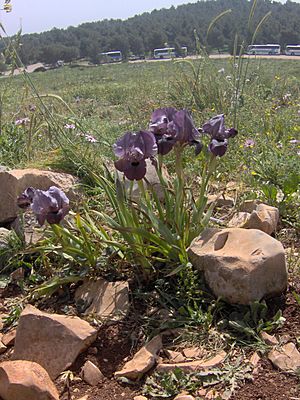Faqqu’a Iris facts for kids
The Gilboa Iris or Faqqu’a Iris (Iris haynei) is a beautiful flower. It belongs to the Iris plant family. This special iris grows from a thick underground stem called a rhizome. It is a perennial plant, meaning it lives for more than two years. You can find it growing on mountainsides and in shrublands in Palestine.
Discovering the Gilboa Iris
In Arabic, this flower is called سوسن فقوعة. It was first found on Mount Gilboa in Palestine. A person named Hayne discovered it in April 1872. Later, in 1876, a scientist named John Gilbert Baker officially named and described the plant. He wrote about it in a magazine called The Gardeners' Chronicle. His description was based on the dried plant samples that Hayne had collected.
Where Does It Grow?
The Gilboa Iris naturally grows in Western Asia. It prefers places with a temperate climate. This means the weather is not too hot and not too cold. It is a plant that is native to this region, meaning it has grown there for a very long time.
A National Symbol
The Gilboa Iris is very important in Palestine. On April 5, 2016, the Ministry of Environmental Affairs (Palestine) chose it as the national plant of the State of Palestine. This means it is a special symbol for the country. It joins other national symbols like the Olive tree (national tree) and the Palestine sunbird (national bird). March 5 is also celebrated as the national day for the Palestinian environment.


